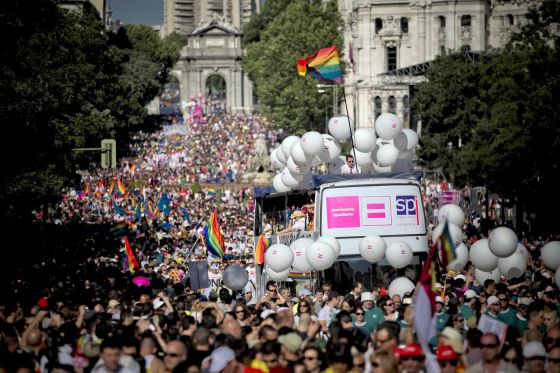in: http://elpais.com/elpais/

A view of Saturday's parade between Puerta de Alcalá and Plaza de España. / EMILIO NARANJO (EFE)
Between 700,000 (according to police) and 1.2 million people (according to organizers) packed into downtown Madrid to watch the Gay Pride parade on Saturday. The highlight of the five-day celebration featured 19 floats that slowly covered the distance between Puerta de Alcalá and Plaza de España amid loud music and wild dancing; yet the festive mood barely concealed widespread concern that the Constitutional Court might be on the verge of repealing groundbreaking legislation allowing same-sex marriage in Spain.
Another cause for concern was the recent budget cut to the public health system, which some fear will affect access to HIV treatments.
Indeed, several people complained about a lack of real content in an event that has grown to become one of Europe’s largest celebrations of LGTB Pride (Lesbian, Gay, Transsexual and Bisexual), a term that event organizers prefer to Gay Pride.
“I’ve participated in many of these,” recalled Javier, 57. “We demanded real political change. Right now this looks like a carnival.”
Another popular event during the Gay Pride celebration was the Carrera de Tacones, a race in which runners compete in stiletto shoes. The competition has been held for 18 years on Pelayo street, in the heart of Chueca, Madrid’s gay neighborhood. The winner this year was a 29-year-old who called himself “Alien” and who left his competition far behind.
But demonstrating for gay rights was not always this easy or this much fun. Victoria Virtudes, “Vito” to her friends, is a 55-year-old activist who has been on the front lines since the late 1970s, and she remembers harsher times.
“They hurled eggs at us and called us butches,” she said. One of the first street demonstrations she went to was in Plaza de Callao, and it was organized by Madrid’s association of lesbian feminists. She is unsure whether it was in 1976 or 1977, “but it’s been over 35 years for sure.” They were just around 20 women present, and Spain was still in a transitional phase that felt more dictatorial than democratic.
Now Vito looks around at Plaza de Chueca, the symbol of the battle for gay rights since 1978, and congratulates herself on everything that has been achieved since the days when they were considered “socially dangerous” under Franco. “We’d lost our fear of coming out of the closet and the homes where we were hiding. But we were also perplexed. We thought there would be very few of us, and in the end it turned into a full-fledged demonstration.”
Alejandro Alder joined the movement much more recently having been born in that key transitional year of 1978. “We have references to look up to. We are still fighting for the same things: freedom, respect for diversity and human rights. We want to be exactly the same as a heterosexual.”
http://elpais.com/

Sem comentários:
Enviar um comentário